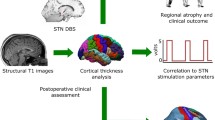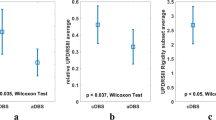Abstract
Purpose
The aim of this follow-up study was to assess persistent motor and regional cerebral blood flow (rCBF) changes in patients with Parkinson’s disease (PD) treated with high-frequency deep brain stimulation (DBS) of the subthalamic nucleus (STN).
Methods
Ten PD patients with STN-DBS underwent three rCBF SPECT studies at rest, once preoperatively in the off-drug condition (T0), and twice postoperatively in the off-drug/off-stimulation conditions at 5 ± 2 (T1) and 42 ± 7 months (T2). Patients were assessed using the UPDRS, H&Y and S&E scales. SPM was used to investigate baseline rCBF changes from the preoperative condition to the postoperative conditions and the relationship between rCBF and UPDRS scores used as covariate of interest.
Results
Parkinsonian patients showed a clinical improvement which was significant only on follow-up at 42 months. The main effect of treatment from T0 to T1 was to produce baseline rCBF increases in the pre-supplementary motor area (pre-SMA), premotor cortex and somatosensory association cortex. From T1 to T2 a further baseline rCBF increase was detected in the pre-SMA (p < 0.0001). A correlation was detected between the slight improvement in motor scores and the rCBF increase in the pre-SMA (p < 0.0001), which is known to play a crucial role in clinical progression.
Conclusion
Our study suggests the presence of adaptive functional changes in the human brain of PD patients treated with long-term STN-DBS. Such adaptive processes seem to occur in the pre-SMA and to play only a slightly beneficial role in terms of functional compensation of motor impairment.





Similar content being viewed by others
References
Hallett M. Plasticity. In: Mazziotta JC, Toga AW, Frackowiak RSJ, editors. Brain mapping: the disorders. San Diego, CA: Academic Press; 2000. p. 569–86.
Otte A. The plasticity of the brain. Eur J Nucl Med 2001;28:263–5.
Chollet F, Weiller C. Recovery of neurological function. In: Mazziotta JC, Toga AW, Frackowiak RSJ, editors. Brain mapping: the disorders. San Diego, CA: Academic Press; 2000. p. 587–97.
Valldeoriola F, Pilleri M, Tolosa E, Molinuevo JL, Rumia J, Ferrer E. Bilateral subthalamic stimulation monotherapy in advanced Parkinson’s disease: long-term follow-up of patients. Mov Disord 2002;17:125–32.
Vingerhoets FJG, Villemure JG, Temperli P, Pollo C, Pralong E, Ghika J. Subthalamic DBS replaces levodopa in Parkinson’s disease. Two-year follow-up. Neurology 2002;58:396–401.
Haberler C, Alesch F, Mazal PR, Pilz P, Jellinger K, Pinter MM, et al. No tissue damage by chronic deep brain stimulation in Parkinson’s disease. Ann Neurol 2000;48:372–6.
Albin R, Young AB, Penny JB. The functional anatomy of basal ganglia disorders. Trends Neurosci 1989;12:366–75.
De Long MR. Primate models of movement disorders of basal ganglia origin. Trends Neurosci 1990;13:281–5.
Benazzouz A, Hallet M. Mechanism of action of deep brain stimulation. Neurology 2000;55 Suppl 6:13–6.
Lang AE, Lozano AM. Parkinson’s disease. N Engl J Med 1998;16:1130–43.
Limousin P, Greene J, Pollak P, Rothwell J, Benabid AL, Frackowiak R. Changes in cerebral activity pattern due to subthalamic nucleus or internal pallidal stimulation in Parkinson’s disease. Ann Neurol 1997;42:283–91.
Sestini S, Scotto di Luzio A, Ammannati F, De Cristofaro MTR, Passeri A, Martini S, et al. Changes in regional cerebral blood flow caused by deep-brain stimulation of the subthalamic nucleus in Parkinson’s disease. J Nucl Med 2002;43:725–32.
Turner RS, Henry T, Grafton S. Therapeutics: surgical. In: Mazziotta JC, Toga AW, Frackowiak RSJ, editors. Brain mapping: the disorders. San Diego, CA: Academic Press; 2000. p. 613–32.
Sestini S, Ramat S, Formiconi AR, Ammannati F, Sorbi S, Pupi A. Brain networks underlying the clinical effects of long-term subthalamic stimulation for Parkinson’s disease: a 4-year follow-up study with rCBF SPECT. J Nucl Med 2005;46:1444–54.
Boccacci P, Bonetto P, Calvini P, Formiconi AR. A simple model for the efficient correction of collimators blur in 3D SPECT images. Inv Probl 1999;15:907–30.
Friston KJ, Frith CD, Liddle PF, Frackowiak RSJ. Comparing functional (PET) images: the assessment of significant change. J Cereb Blood Flow Metab 1991;11:690–9.
Friston KJ, Ashburner J, Frith CD, Poline JB, Heather JD, Frackowiak RSJ. Spatial registration and normalization of images. Human Brain Mapp 1995;3:165–89.
Lancaster JL, Woldorff MG, Parsons LM. Automated Talairach atlas labels for functional brain mapping. Human Brain Mapp 2000;10:120–31.
Benabid AL, Koudsie A, Benazzouz A, Piallat B, van Blerkom N, Fraix V, et al. Subthalamic nucleus deep brain stimulation. Prog Neurol Surg 2000;15:196–226.
Kumar R, Lozano AM, Kim YJ, Hutchison WD, Sime E, Halket E, et al. Double-blind evaluation of subthalamic nucleus deep brain stimulation in advanced Parkinson’s disease. Neurology 1998;51:850–5.
Molinuevo JL, Valldeoriola F, Tolosa E, Rumià J, Valls-Solé J, Roldan H, et al. Levodopa withdrawal after bilateral subthalamic nucleus stimulation in advanced Parkinson disease. Arch Neurol 2000;57:983–8.
Thobois S, Mertens P, Guenot M, Hermier M, Mollion H, Bouvard M, et al. Subthalamic nucleus stimulation in Parkinson’s disease. Clinical evaluation of 18 patients. J Neurol 2002;249:529–34.
Rodriguez-Oroz MC, Gorospe LM, Guridi J, Ramos E, Linazasoro G, Rodriguez-Palmero M, et al. Bilateral deep brain stimulation of the subthalamic nucleus in Parkinson’s disease. Neurology 2000;55 Suppl 6:45–51.
Simuni T, Jaggi JL, Mulholland H, Hurtig H, Colcher A, Siderowe AD, et al. Bilateral stimulation of the subthalamic nucleus in patients with Parkinson disease: a study of efficacy and safety. J Neurosurg 2002;96:666–72.
Østergaard K, Sunde N. Evolution of Parkinson’s disease during 4 years of bilateral deep brain stimulation of the subthalamic nucleus. Mov Disord 2006;21:624–31.
Schüpbach WMM, Chastan N, Houeto JL, Mesnage V, Bonnet AM, Czernecki V, et al. Stimulation of the subthalamic nucleus in Parkinson’s disease: a 5 year follow up. J Neurol Neurosurg Psychiatry 2005;76:1640–4.
Geday J, Østergaard K, Gjedde A. Stimulation of subthalamic nucleus inhibits emotional activation of fusiform gyrus. Neuroimage 2006;33:706–14.
Temperli P, Ghika J, Villemure JG, Burhard PR, Bogousslavsky J, Vingerhoets FJG. How do parkinsonian signs return after discontinuation of subthalamic DBS? Neurology 2003;60:78–81.
Maesawa S, Kaneoke Y, Kajita Y, Usui N, Misawa N, Nakayama A, et al. Long-term stimulation of the subthalamic nucleus in hemiparkinsonian rats: neuroprotection of dopaminergic neurons. J Neurosurg 2004;100:679–87.
Lokkegaard A, Werdelin LM, Regeur L, Karlsborg M, Jensen SR, Brodsgaard E, et al. Dopamine transporter imaging and the effects of deep brain stimulation in patients with Parkinson’s disease. Eur J Nucl Med Mol Imaging 2007;3:508–16.
Seibyl J, Jennings D, Tabamo R, Marek K. Unique roles of SPET brain imaging in clinical and research studies. Lessons from Parkinson’s disease research. Q J Nucl Med Mol Imaging 2005;49:215–21.
Warnke PC. STN stimulation and neuroprotection in Parkinson’s disease—when beautiful theories meet ugly facts. J Neurol Neurosurg Psychiatry 2005;76:1186–7.
Windels F, Bruet N, Poupard A, Urbain N, Chouvet G, Feuerstein C, et al. Effects of high frequency stimulation of subthalamic nucleus on extracellular glutamate and GABA in substantia nigra and globus pallidus in the normal rat. Eur J Neurosci 2000;12:4141–6.
Morrish P. Is it time to abandon functional imaging in the study of neuroprotection? Mov Disord 2002;17:229–32.
Bezard E, Gross CE, Brotchie JM. Presymptomatic compensation in Parkinson’s disease is not dopamine-mediated. Trends Neurosci 2003;26:215–21.
Hess G, Aizenman CD, Donogue JP. Conditions for the induction of long-term potentiation on layer II/III horizontal connections of the rat motor cortex. J Neurophysiol 1996;75:1765–78.
Sabatini U, Boulanouar K, Fabre N, Martin F, Carel C, Colonnese C, et al. Cortical motor reorganization in akinetic patients with Parkinson’s disease: a functional MRI study. Brain 2000;123:394–403.
Nudo RJ, Plautz EJ, Frost SB. Role of adaptive plasticity in recovery of function after damage to motor cortex. Muscle Nerve 2001;24:1000–19.
Hirsch EC. Nigrostriatal system plasticity in Parkinson’s disease: effect of dopaminergic denervation and treatment. Ann Neurol 2000;47 4 suppl 1:S115–20.
Ziemann U, Hallett M, Cohen LG. Mechanisms of deafferentation-induced plasticity in human motor cortex. J Neurosci 1998;18:7000–7.
Keller A, Arissian K, Asanuma H. Synaptic proliferation in the motor cortex of adult cats after long-term thalamic stimulation. J Neurophysiol 2002;68:295–308.
Lang AE, Obeso JA. Challenges in Parkinson’s disease: restoration of the nigrostriatal dopamine system is not enough. Lancet Neurol 2004;3:309–16.
Author information
Authors and Affiliations
Corresponding author
Rights and permissions
About this article
Cite this article
Sestini, S., Pupi, A., Ammannati, F. et al. Are there adaptive changes in the human brain of patients with Parkinson’s disease treated with long-term deep brain stimulation of the subthalamic nucleus? A 4-year follow-up study with regional cerebral blood flow SPECT. Eur J Nucl Med Mol Imaging 34, 1646–1657 (2007). https://doi.org/10.1007/s00259-007-0428-z
Received:
Accepted:
Published:
Issue Date:
DOI: https://doi.org/10.1007/s00259-007-0428-z




